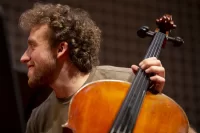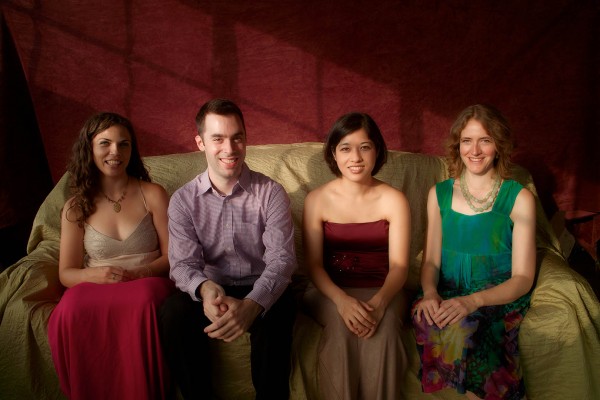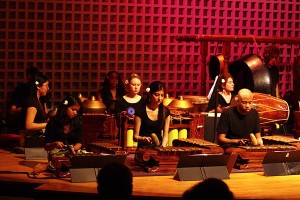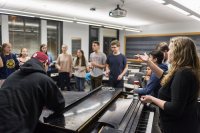
Gamelan, Momenta Quartet collaboration focuses on Western composers
A string ensemble known for its dedication to music by contemporary composers and from cultures underrepresented in mainstream repertory, the Momenta Quartet joins the Bates College Gamelan Ensemble in concert at 7:30 p.m. Friday, Nov. 14, in the Olin Arts Center Concert Hall, 75 Russell St.
Admission is $15 plus a convenience fee of $3 per ticket, available at batestickets.com. A limited number of free tickets for students and seniors 65-plus are available at bit.ly/oacbates. For more information, please contact 207-786-6135 or olinarts@bates.edu.
The program consists of “NONAME,” a composition from 2012 by Jesse Jones, and “Threnody for Carlos Chavez,” a 1979 work by the late Lou Harrison.
Praised by The New York Times for its “focused, fluid performance,” the Momenta Quartet has premiered more than 50 works in the past eight years and has collaborated with more than 80 composers.
Gamelan refers to a family of musical instruments indigenous to Bali and Java, in Indonesia. The instruments consist mostly of tuned bronze percussion, and tend to be created in sets. (Bates has two different sets.)
Despite its long history, gamelan remains a living musical force, says Gina Fatone, associate professor of music and director of the Bates Gamelan Ensemble. “Music for gamelan has become a global phenomenon — not only for listeners, but for composers as well.
“While Bates gamelan students study traditional Indonesian styles, I think it’s important that our curriculum builds their awareness of the many ways in which contemporary composers, both Indonesian and Western, make creative use of gamelan.”
The two pieces on the Nov. 14 program came into being in different ways, each with its own pedagogical value, says Fatone.
Jones’ piece was written in Western notation with a percussion part not specified for gamelan instruments — meaning that the Bates performers had to translate their parts from Western staff notation into the gamelan notation they’re accustomed to.
In addition, Jones’ score calls for only a few instruments. That, says Fatone, necessitated dividing the parts up among multiple players, sometimes on the same instrument, so that everyone in the ensemble could take part in the performance.
“Working out exactly who would play what when has been a bit of a challenge,” she says. “And the piece is composed in a rather experimental idiom that involves technical challenges regardless of the medium. But the students have done a beautiful job with this.”
Harrison’s “Threnody,” in contrast, was written for solo viola and gamelan. The score is in conventional gamelan notation. But the featured soloist, Momenta violist Stephanie Griffin, will guide the tempo and subtle dynamic changes. That’s a departure from standard gamelan repertoire, where there is typically little dynamic change within large sections of a piece.
The Momenta Quartet’s other members are violinists Emilie-Anne Gendron and Adda Kridler and cellist Michael Haas. Based in New York City, the quartet focuses on the work of emerging modern composers, and includes music from many different cultures and genres, including jazz and avant-garde improvisation.
Momenta’s concerts combine the works of living composers with selected great music from the past, creating what The Washington Post calls an “utterly beautiful sonic skyscape.”
In residence at Temple University in Philadelphia, the quartet has performed and lectured at a number of colleges and universities, including Cornell, Columbia, Swarthmore and Haverford.
Momenta has visited Bates several times, most recently last May. “We are incredibly lucky to be performing with an ensemble of such high caliber and one known for a repertoire representing both Indonesian and Western composers,” says Fatone. “In fact, members of Momenta made us aware of this dimension of their work, and we decided to play together this fall.
“We hope this will lead to more collaborations with the quartet.”






